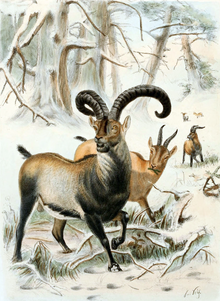Capra pyrenaica pyrenaica
| Pyrenean ibex | |
|---|---|
 |
|
| Illustration from 1898 | |
| Scientific classification | |
| Kingdom: | Animalia |
| Phylum: | Chordata |
| Class: | Mammalia |
| Order: | Artiodactyla |
| Family: | Bovidae |
| Subfamily: | Caprinae |
| Genus: | Capra |
| Species: | C. pyrenaica |
| Subspecies: | †C. p. pyrenaica |
| Trinomial name | |
|
Capra pyrenaica pyrenaica (Schinz, 1838) |
|
The Pyrenean ibex (Capra pyrenaica pyrenaica), Spanish common name bucardo, was one of the four subspecies of the Spanish ibex or Iberian wild goat, a species endemic to the Iberian Peninsula. Pyrenean ibex were most common in the Cantabrian Mountains, Southern France, and the northern Pyrenees. This species was common during the Holocene and Upper Pleistocene, during which their morphology, primarily some skulls, of the Pyrenean ibex was found to be larger than other Capra subspecies in southwestern Europe from the same time.
In January 2000, the Pyrenean ibex became extinct, but it has since become one of the primary missions of scientists attempting to bring it and other species back from extinction. Other subspecies have survived, though: the western Spanish or Gredos ibex and the southeastern Spanish or beceite ibex, while the Portuguese ibex had already become extinct. Since the last of the Pyrenean ibex became extinct before scientists could adequately analyze them, the taxonomy of this particular subspecies is controversial.
Following several failed attempts to revive the subspecies through cloning, a living specimen was born in 2003. However, this victory was short lived, as the specimen died several minutes later due to a lung defect.
Multiple theories are given regarding the evolution and historical migration of C. pyrenaica into the Iberian Peninsula, and the relationship between the different subspecies.
One possibility is that C. pyrenaica evolved from an ancestor related to C. caucasica from the Middle East, at the beginning of the last glacial period (120–80 ky).C. pyrenaica probably moved from the northern Alps through southern France into the Pyrenees area at the beginning of Magdalenian period about 18 kya. If this is the case, then C. caucasica praepyrenaica may have been more different from the other three ibex species that lived in the Iberian Peninsula than scientists currently know. For example, this would mean that the C. pyrenaica (possible migration 18ky) and C. ibex (300 ky earlier migration) would have evolved from different ancestors and been morphologically more different from their separate genes. It is known that all four subspecies lived together in the Upper Pleistocene time, but scientists are unsure of how much genetic exchange could have occurred. The problem with this theory is that genetics suggest that C. pyrenaica and C. ibex may have shared a more common origin, possibly C. camburgensis.
...
Wikipedia

